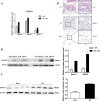Periostin promotes the proliferation and metastasis of osteosarcoma by increasing cell survival and activates the PI3K/Akt pathway
- PMID: 35057799
- PMCID: PMC8780812
- DOI: 10.1186/s12935-021-02441-6
Periostin promotes the proliferation and metastasis of osteosarcoma by increasing cell survival and activates the PI3K/Akt pathway
Abstract
Background: Silencing of the periostin gene (POSTN) can inhibit the biological process of several different cancers, and this inhibition may be related to down-regulation of PI3K/AKT signaling. However, the effect of POSTN on the progression, proliferation, and invasion of osteosarcoma (OS) remain unclear.
Methods: We used the Gene Expression Omnibus (GEO) database to screen datasets on in situ OS and lung metastases to identify core genes and potential pathways. We used additional bioinformatics tools to identify protein-protein interactions (PPIs) and gene networks, and selected the top seven genes whose expression had the strongest correlations with other genes.
Results: The results indicated that POSTN was a major hub gene. Subsequent analysis of gene expression profiles showed that POSTN was highly expressed in 262 cases with sarcoma and expression was closely related to poor prognosis. We also performed enrichment analysis to identify differentially expressed genes and used real-time PCR, western blotting, and immunohistochemistry analyses to measure POSTN expression in cells and tissues. Transfection of a POSTN-shRNA plasmid into cultured OS cells (Saos-2) effectively inhibited the proliferation, invasion, and migration of these cells. Taken together, our results suggest that POSTN may play a role in promoting the proliferation and metastasis of OS by activation of the PI3K/Akt signaling pathway.
Conclusions: Our results provide a preliminary characterization of the mechanism by which POSTN may regulate the migration and invasion of OS cells and also provide a theoretical basis for identifying biomarkers that have potential use for the diagnosis and treatment of OS.
Keywords: Metastasis; Osteosarcoma; POSTN (Periostin); Pathway; Proliferation.
© 2022. The Author(s).
Conflict of interest statement
All of the authors agreed the publication of the paper and declare no conflicts of interests.
Figures










References
-
- Yoshiba N, Yoshiba K, Hosoya A, Saito M, Yokoi T, Okiji T, Amizuka N, Ozawa H. Association of TIMP-2 with extracellular matrix exposed to mechanical stress and its co-distribution with periostin during mouse mandible development. Cell Tissue Res. 2007;330(1):133–45. doi: 10.1007/s00441-007-0439-x. - DOI - PubMed
Grants and funding
LinkOut - more resources
Full Text Sources
Miscellaneous

